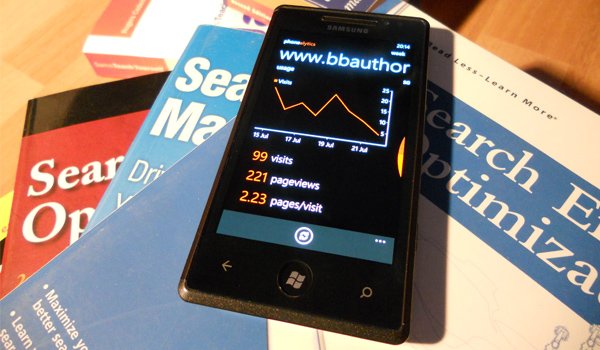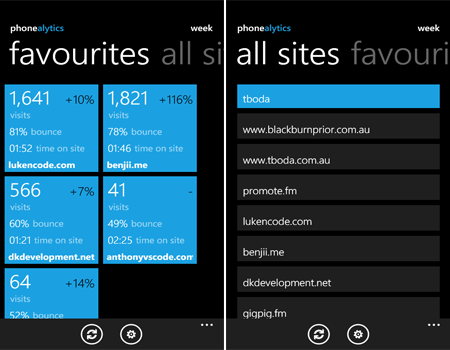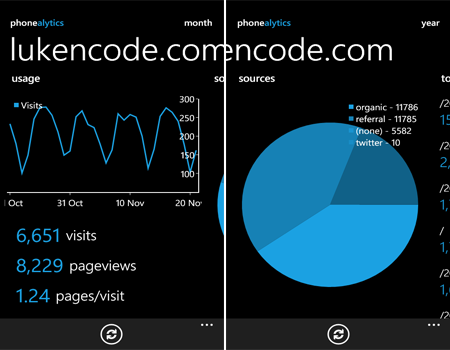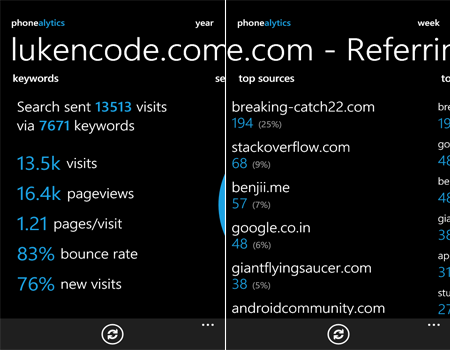Phonealytics - Review

Analytics, the right-hand man for any web developer or e-consultant, is the base of all marketing campaigns, social expeditions and performance reports for any website. Google Analytics is the freely available and widely used software offered by the search giant for webmasters to take advantage of. The beauty of Google Analytics is the integration it has with Feedburner and Adsense as well as available APIs. It's freely available and offers webmasters with a fairly accurate picture of how a web property is performing (should visitors have JavaScript enabled). Although one must remember that nothing can compare to server-side software like AWStats etc. with accuracy.
The most useful data that's looked at includes visits/visitors, bounce rate, time-on-site and sources. As mentioned above, it's vital for marketing, reports and optimization of software or pages. Visits and visitors are counted and recorded to calculate the ratio for new visits against returning visitors. Bounce rate determines how relevant or effective your site is to captured audience. Time-on-site is pretty self-explanatory, while sources covers where visitors came from (be it search engines, direct or referring sites).
Unfortunately, since Google Analytics makes use of Flash for graph rendering, the service is less-than available on smartphone platforms that do not support Flash. How would a Windows Phone user keep up with site statistics while on the go? Allow me to introduce Phonealytics, by Luke Lowrey.
Introduction
Phonealytics, a Google Analytics client for Windows Phone, provides mobile access to profiles and websites on Google accounts with the added support for live tile. Following the Metro UI design standards rule to the letter, this app is probably one of the most aesthetically pleasing apps installed on my handset (tied with 4th&mayor). Because Phonealytics is solely based on themes, which ever colour you have applied will reflect throughout the entire app, even the logo. Luke has implemented many small touches like this that ensures the user experience is best at a constant level.
Upon entering the app for the first time, you'll need to enter your Google account credentials. After this has been carried out, one will see all properties tied to the account in the "all sites" pane. The app home screen (if you haven't noticed already) is a live tile list of favourites. This works much like other app in the Marketplace, push and hold on a website in "all sites" and you'll be able to pin that site to "favourites" for easy access.

We'll stick to "favorites" for a moment longer as there's more to this screen than meets the eye. In each tile the user will see useful information (which we covered above) including the number of visits, the bounce rate and average time-on-site. Perfect for the 'quick glance' usage. In the control bar we have the refresh and settings icons, but expanding the bar will reveal some filters. These expand or contract the time range for the data, one can select day, week, month or year. The current setting can be seen in the top right corner, opposite the app logo.
Live tiles
Before heading into the data presentation (yes, there are pretty graphs too), we'll touch on the live tile support. We recently published a how to for working the live tile as sometimes your Google account might not be logged in thus preventing the live tile from refreshing (or showing at all). When enabled the user has the same filters available to configure what the tile reports - day, week, month or year. What does the tile offer along with the "favorites" screen? Performance monitoring. With the tile enabled, a site selected and filters applied the app will calculate the percentage increase/decrease in the number of visits. This is also present on the favorites list.
All the latest news, reviews, and guides for Windows and Xbox diehards.
If the day filter is enabled, the percentage will reflect the change from the day before. With week selected, the previous week will be counted, and so on. Hopefully with Mango we'll see multiple tiles being enabled so users can have more than one property pinned to their home screen.
Reports
Moving onto reporting, selecting a site in Phonealytics will take you deeper into the realm of analysis and analytics. The first screen displayed is the overview. This pane features a line graph representing the number of visits with the selected filter (remember day, week, etc.?). Underneath are the figures for number of visits, page views, pages per visit, bounce rate and new visits.

Swiping to the left will bring in the big guns - a massive pie. This chart shows the breakdown of sources into three categories: direct (bookmarks, address bar entry, etc.), referral (websites) and organic (search engines). Swiping again to the left will bring us to the content diagnosis. This detailed list shows the user which pages and sections of the website are performing best with receiving most page views.
On the last pane we have extra reports - search engine and site referral analysis. Both are fairly self-explanatory. The search engine report provides the user an insight into what keywords are being used in searches where the visitor ends up entering your website and from which search engine. The referring site report details what websites have provided you with most traffic as well as individual paths that visitors came from (these URLs can be selected and viewed in IE).

Conclusion
Overall, Phonealytics is a feature-packed Google Analytics client and is a fantastic example of Metro UI at its best. Luke is taking feedback and is regularly updating the app with new features so be sure to use the included contact address (found in the settings) to voice your opinion and what you'd like to see. Myself, I would be very happy with Adsense integration. The web client of Google Analytics has minor support for Adsense so it would be nice for this data to be pulled and displayed.
Check out our video review below for a visual run through:
You can purchase Phonealytics from the Marketplace for $1.99. A free version was made available too with no advertisements, the only drawback being no live tile support. We have previously interviewed Luke, the developer of Phonealytics, to receive his take on WP7 development. It's a good read.

Rich Edmonds was formerly a Senior Editor of PC hardware at Windows Central, covering everything related to PC components and NAS. He's been involved in technology for more than a decade and knows a thing or two about the magic inside a PC chassis. You can follow him on Twitter at @RichEdmonds.
